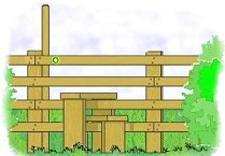Guidance on stiles and gates
Information relating to stiles, gates and gaps on public rights of way.

The landowner, by law, has a duty to maintain structures such as gates and stiles on rights of way on their land. We can provide grants of up to 25% towards the cost of replacing stiles and gates. Where possible gates and stiles should conform to British Standards Institute (BS5709:2018). Generally, new stiles can not be erected where there were none previously. Please contact us if you have any queries.
Temporary electric fencing must have a suitable crossing point where it intersects a right of way.
Gates
Gates must open freely, for example they must be properly hinged and have a suitable fastening device (latch, loop or bolt). Gates that are tied shut with twine, wire or locked in any way are considered an obstruction and gates can not be erected across a right of way where none previously existed, other than for controlling stock.
If gates are required for containing stock your local access and rights of way officer must be consulted prior to installation.
From an accessibility point of view, wherever practical, a gap is always preferred over a gate and a gate is preferable over a stile.
There are various designs of stile and gate for footpaths and bridleways and to suit different boundary types. New or replacement stiles should conform to British Standard specifications, however, they can be adapted to suit the location and topography.
Click on the links below to see detailed drawings:
- Standard Stiles (PDF, 78 KB)
- Alternative Stile (PDF, 84 KB)
- Stiles Over Wire (PDF, 84 KB)
- Stone Wall Stile (PDF, 186 KB)
- Bridlegates (PDF, 211 KB)
- Wood Kissing Gates (PDF, 199 KB)
- Footpath Barriers (PDF, 182 KB)
- Gaps (PDF, 65 KB)
- Metal Bridleway Step-through Gate (PDF, 81 KB)
Gaps or standard bridleway gates are generally preferable to the metal bridleway boomgates. These are suitable when vehicle access needs to be controlled and the width available is not sufficient for a bridlegate or gap and a vehicular gate.
- Email prow@durham.gov.uk
- Telephone 03000 265 342

 Share this page on Facebook
Share this page on Facebook
 Share this page on Twitter
Share this page on Twitter
 Print this page
Print this page





